I’ll be the first to say it. My brother and I have dramatically different approaches to playing a modular synth. This fact makes it tough to plan out a case for the both of us to play simultaneously. He’s a guy that plugs stuff in seemingly indiscriminately, and twists knobs until he finds something he thinks he can work with. I tend to have a very good idea of what I’d like to accomplish and plan methodical ways of making it happen. He likes a swarm of saw waves into a juicy filter. I like very basic sound waves like sines or triangles, and wavetables into wavefolders or with some light FM. He’s a drum and bass producer. I create ambient music with drones and light pings. Everything about how we go about patching a modular synth is diametrically opposed. But it also means that when we patch together, which is never a serious effort and only to waste time doing something fun, we both end up tending towards something that neither of us would generally do on our own. It expands horizons and provides for some interesting results. Last year we basically made noise. Not technical noise, and not even really metaphorical noise, but more like background noise. The sound of a server room in space. Deep hums with envelopes streaking through Odessa to create harmonic shooting stars, and the like. I was much less experienced a year ago, and just kind of went along with it. It was all very cool, and we had a good time. But this year was a little different.
Because I’m a nerd, I spend an inordinate amount of time thinking about playing modular. When I’m not actually playing the synth, I’m constantly perusing forums in order to talk about synths, or I’m reading one of the several synth books I have, or I’m writing about my patch ideas in Notability, or watching YouTube for patching techniques. And when I’m away from all of that I run patches in my head over and over trying to imagine ways to approach problems. I’ve made dozens of patches this past year, and even more recordings.1 Of the 45 posts on this blog (not including the current one), 43 are from this year alone. I’m far more experienced than I was a year ago. Even if I know I still have much to learn, I’m more confident in myself and have a much broader skill set and larger bag of tools than I did a year ago.
Night One
When my brother first sat down at the synth, I thought I was gonna have a heart attack. The very first thing he did was mult a single output of Swell Physics to at least eight CV inputs across the system. After patching up all four oscillators of the E370, he decided that, despite there being a fully featured quad filter front and center, he wanted to use the new (and completely unfamiliar to the both of us) Disting NT as a filter. Rather than use the Addac506 Stochastic Function Generator for envelopes, he was digging through Ornament and Crime. I had no idea what he was doing, and for a minute I wasn’t sure he did either. But it was soon clear he was experimenting. Being a homer for modules with screens, the Disting NT was instantly interesting to him. He wanted to see what it could do.
This first patch was a little awkward. He finally gave up on using Disting NT as a filter, and we instead Pinged CUNSA and the four E370 outputs which was a good compromise for what he was trying to do. A single v/oct signal was sent from the Doboz T12 touch controller to all four oscillators tuned at different intervals. This is the only pitch change happening and it only happens when we thought to do it. After a while we introduced delays and then opened the filters as we added modulation to each side of the delay. Later on we added a smidge of granular processing courtesy of the Bram Bos + Hainbach Fluss plugin. It’s not a great patch, but it was fun. Both of us were becoming accustomed to this synth, the tools in it, and each other. Some modules, like the Disting Ex and Doboz Prizma Mk2, we just didn’t understand, and since he only owns a couple of the modules in this case, most of it was very unfamiliar to him. It took a long time to get these results, and though we both knew this patch wasn’t what we hoped it might be, both of us were happy enough. It’s just fun time anyways.
Night Two – The First Patch
Night two was a very different story. I started a patch by pinging three of the four CUNSA filters bongo style using the wonderful Jonah Senzel Pet Rock, a dual channel trigger generator that creates exactly one pattern per channel per day, and a random clock output at some clock multiplication I don’t remember.
Pet Rock is a very basic module. Input a clock, and take the output to your gate/trigger input of choice. You get one pattern per day, and everyone in the world who owns one gets the same pattern. It goes by moon cycle, and its mood reflects the moon cycle. At midnight it changes to the next day’s pattern without any input whatsoever. It’s certainly a fun musical experiment, even if it’s not something I’d use all the time. It was fun to hear the switchover from the Christmas Eve to the Christmas Day pattern (it happened while we were building the second patch of Night Two). You can hear the pattern very clearly, even while the third trigger does its own thing.
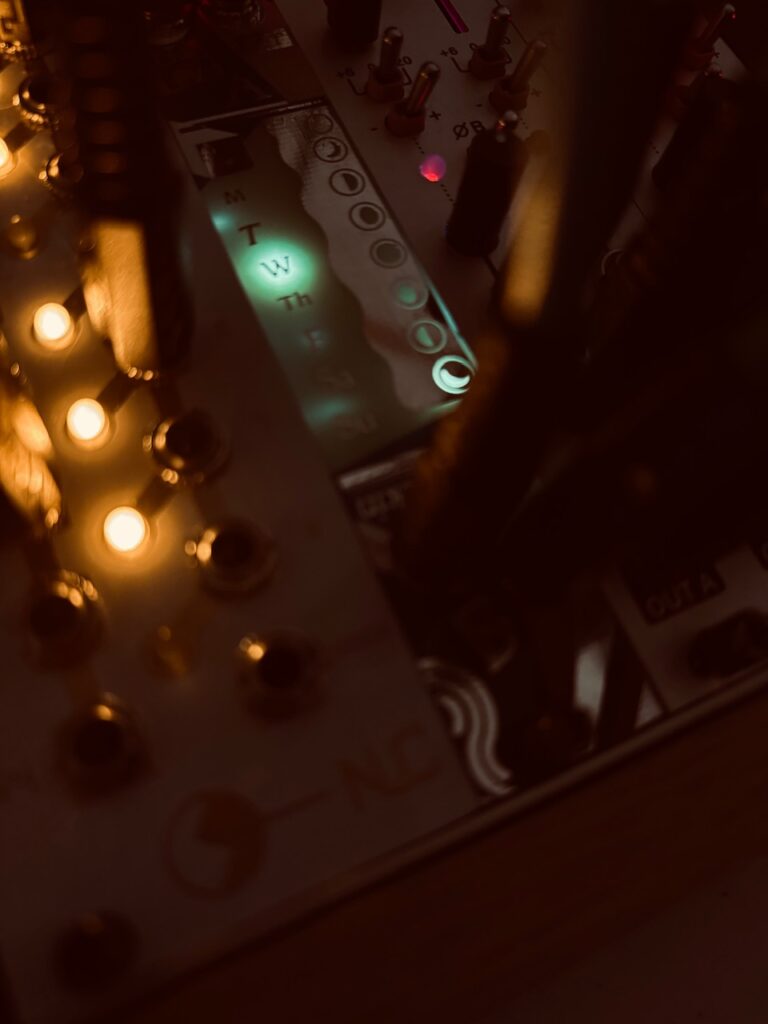
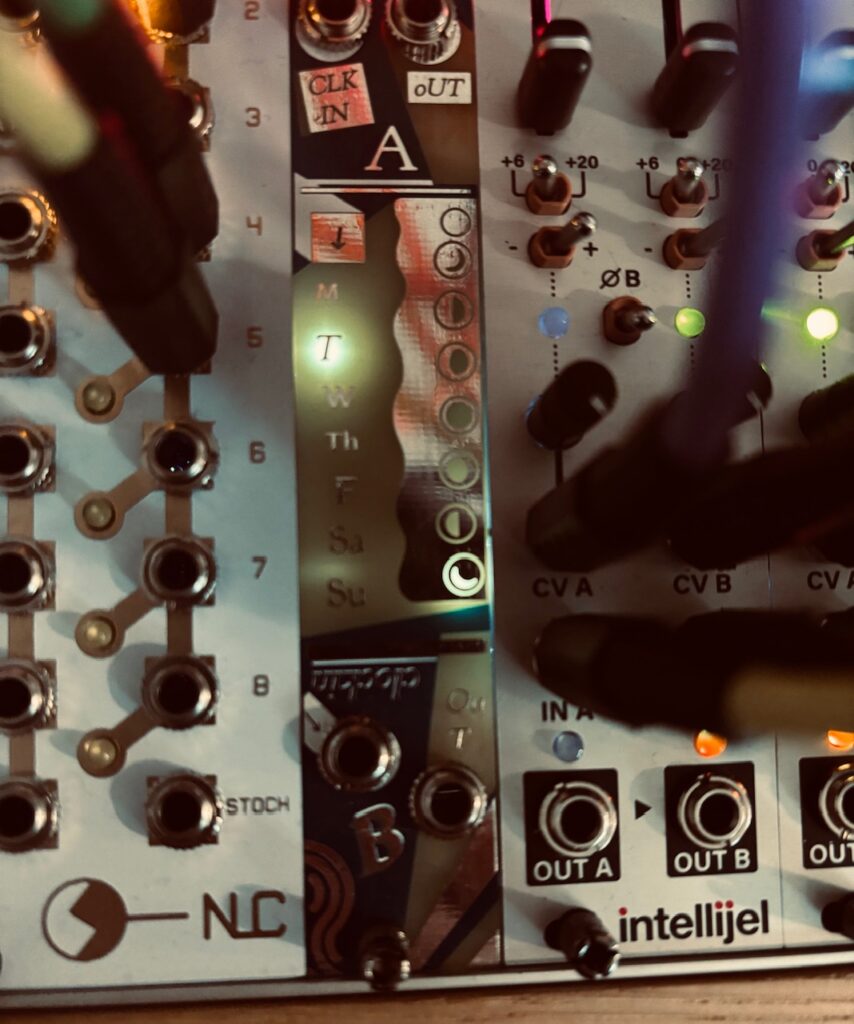
I sent two of the CV outputs on the Nonlinearcircuits Stochaos to Amps for attenuation, and on to two of CUNSA’s FM inputs for pitch changes to keep the bongos more interesting. These bongos are sent through a modulated Veno-Echo that regularly changes time per side, feedback, mix, and stereo width. The Veno-Echo outputs go to the mixer for some reverb before going to the output.
While I was busy honing the bongos in, my brother was hard at work creating a tone with the Disting NT he thought would go well with the atmosphere of the bongos that he could control as an improvised voice using the T12. Although he struggled mightily to figure out how to control the many facets of the Disting NT (to be fair, both of us wrestled a lot with it), he ran into a nice enough sound, and we went with it. He used the pressure output from the T12 to control volume. From the VCA, the oscillator went through the last open channel in the CUNSA and out to the mixer for some reverb. It’s not a complicated patch, not by any means. It’s just simple pinging, along with an improvised synth line on top. But it was coherent and showed promise.
Night Two – The Second Patch
For the second patch of the night I took control of the Disting NT in order to use it for the primary reason I bought it: as a polyphonic multisample player. Clearing the previous patch, I immediately added a Poly Multisample algorithm and assigned the gate and CV to Inputs 1 and 2. I wanted to added several more gates and CV sources so that I could use Stochaos as its source, but couldn’t figure out how to add more CV/gate pairs and simply moved on. Wanting to explore the NT a bit more, I chose to use the Shift Register (Turing Machine) algorithm as the pitch and gate source. It worked a treat, even if I did it “wrong.” The beauty of the Disting NT is that entire patches can be completed in just one module. Add Clock, Shift Register, Quantizer, and Poly Multisample algorithms to a patch, and I could have it running without a single cable. It even has its own delay and reverb algorithms for good measure. We wanted an external clock, which we used, but I didn’t understand how to route the gate and CV outputs from the Shift Register directly to Poly Multisample, so output the signals and patched to the gate and CV inputs for Poly Multisample on the front panel. I also could have used an internal quantizer, but chose to use Quantermain in the uO_C because I was tired of fumbling around Disting menus for the night.2 We put a 0hp attenuator on the Disting CV output, and before Quantermain, to have manual control over the pitch range, which was a really nice performative touch. I suppose the patch isn’t technically “wrong”, but it is inefficient, and could have been accomplished without a single patch cable, or just one since we were determined to use an external clock.
The Soft Piano multisamples were sent to the Veno-Echo (with some slight but noticeable sample reduction) for some delay, while being lightly, and then a little more heavily, modulated by Swell Physics, with its various outputs modulating feedback and width, while its two gate outputs turned reverse on and off per side. From the Veno-Echo, the piano went to the mixer for some reverb.
After we got the multisample player set, we went to work on the kick drum and hi-hats. The kick is created by ringing a CUNSA filter input with an envelope from the Addac506, which was triggered by the Pet Rock. We sent the same envelope to the FM CV input to give the kick a bit of punch. The hats were created using the Pink Noise output from the Stochaos, sent through a HPF and enveloped using a second Addac506 function which had a slight set of variance in attack, but a fairly wide set of variance in the fall section to give some variety and openness to the hi-hat hits. The kick drum is a sort of weird kick. It’s actually a low sine wave drone that is being enveloped. We both liked the droning and thought droning was a better choice than leaving it as a straight kick. It helps fill in space and provides for a certain mood that wasn’t conveyed by the kick alone. These went straight to the mixer, with the hats getting some reverb, but not the kick. A very last minute decision had my brother switched the hi-hat and kick pattern from Pet Rock, which was much better. When we started this patch it was still Tuesday night. By the time we were ready to record it was Wednesday morning, and the pattern had changed.
Both of us were incredibly happy with this patch, despite our fumbling around Disting NT menus. It’s a lot closer to something I might normally make, but that wasn’t a deterrent for my brother who went along with it and was really impressed with how playable the patch was by controlling the start/stop of the clock and by using the attenuator to control the range of piano notes we’d hear. It starts with a single pitch, and slowly expands outwards before coming back to a single pitch by the end.
The balance of this patch is all jacked up. The kick is too loud, and the hats too soft. Both of us were using unfamiliar headphones, and we were deceived. We should have believed the level meters in the mixer more than our lying headphones. It’s not a completely awful mix, but it could be much better.
The third night, alas, wasn’t meant to be.
Despite having a highly capable synth, I’m not completely happy with the module choices I made. Not because the modules are bad, but because there were simply too many of them that I didn’t even have a faint grasp on. We fumbled our way through the Disting NT, which is a testament to how good the UI is being that’s it’s also a very deep and complicated module with dozens of features. But we were never able to use the Doboz Prizma Mk2 at all. It was completely opaque. I should have done more than a light perusing of the manual the night before I left. I should have put my hands on it and figured at least how to get something out of it before slapping it in a case as a primary sequencer. It was a waste of 6hp, and a not insignificant amount of precious time. Had I made even a minimal effort to learn something about the module before I left, our patching might have been completely different.
I really dig making these travel synths to play with my brother. We both end up getting something from it. Him, some access to gear he doesn’t own alongside my very different patching methodology, while I’m able to see how someone else with very different tastes would patch my modules. The both of us get to spend some valuable time together doing something we both love.
For a list of modules in this case, see this post.
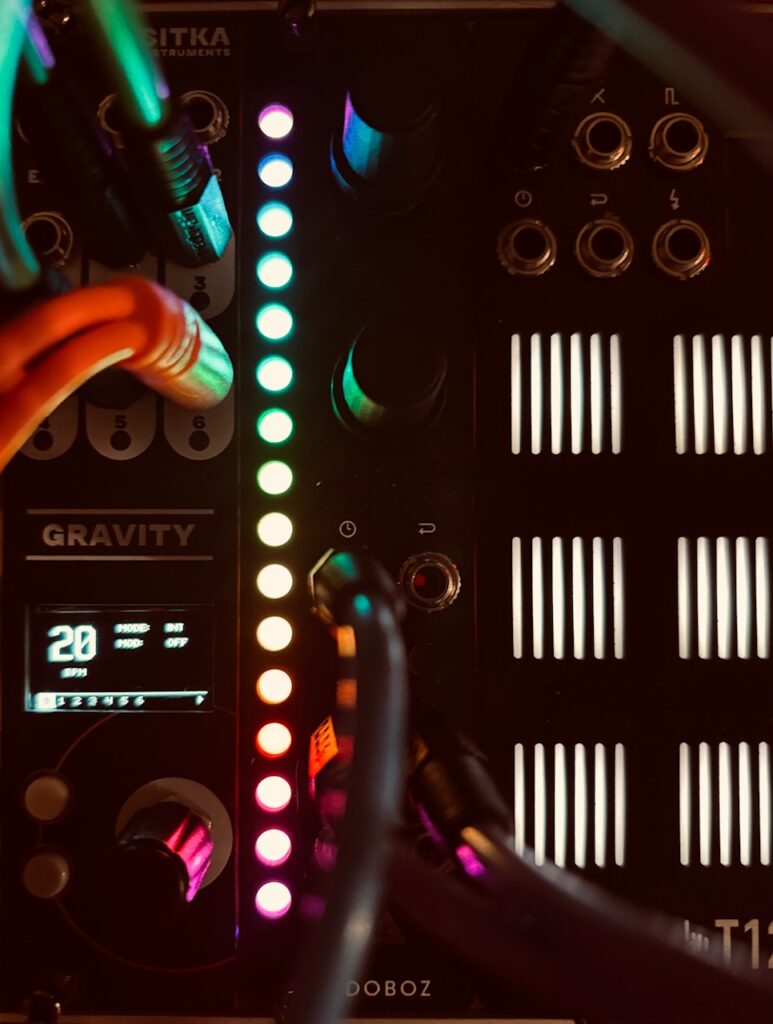
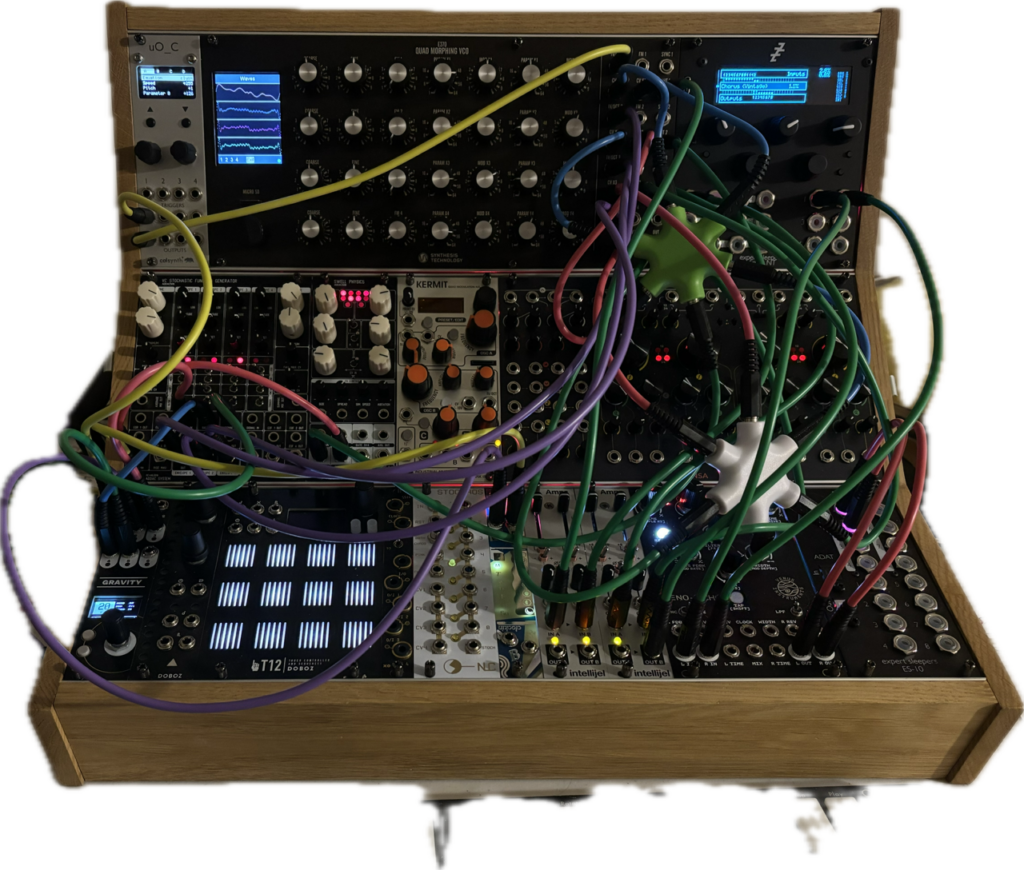
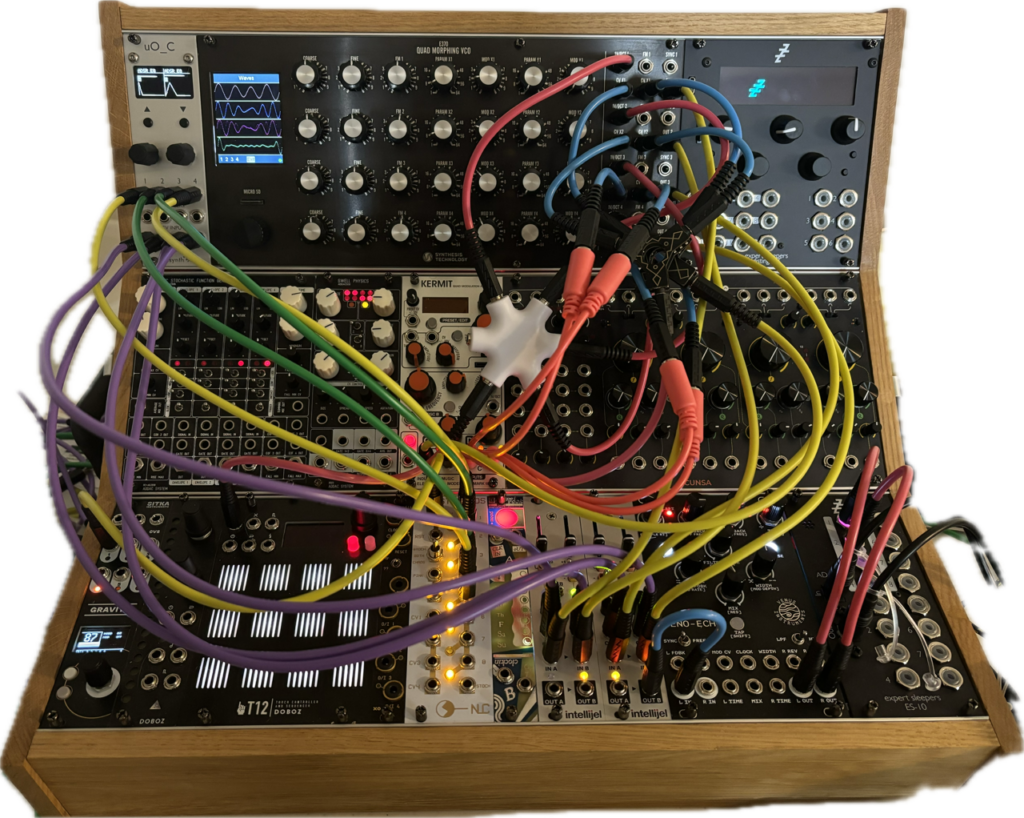
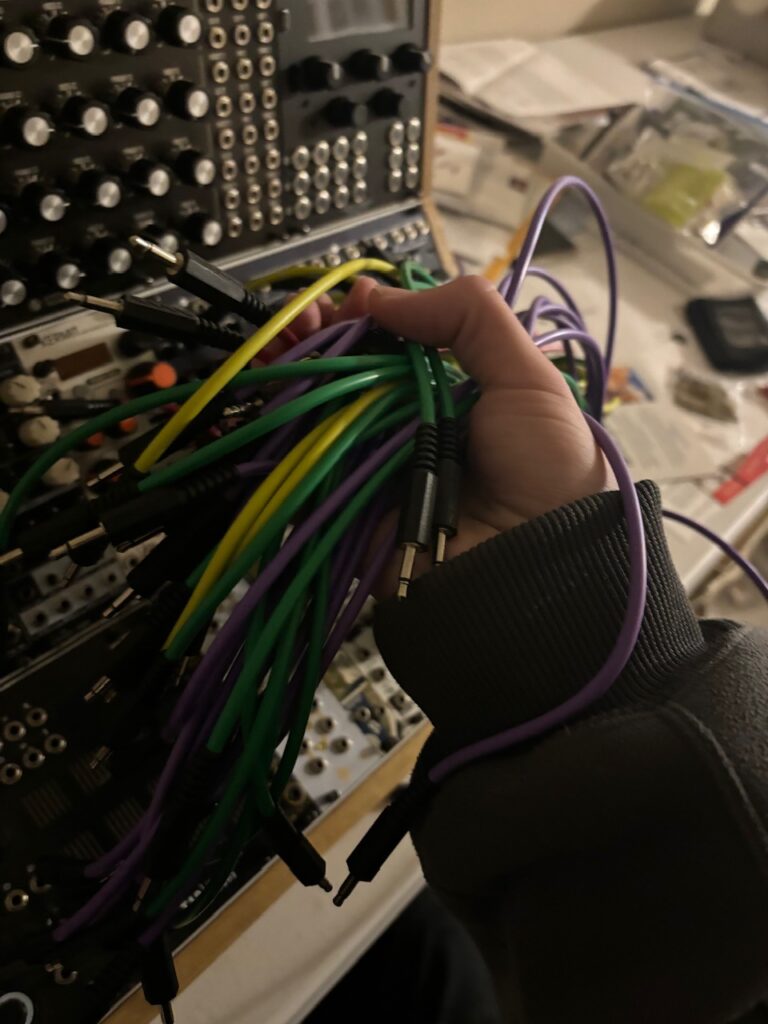
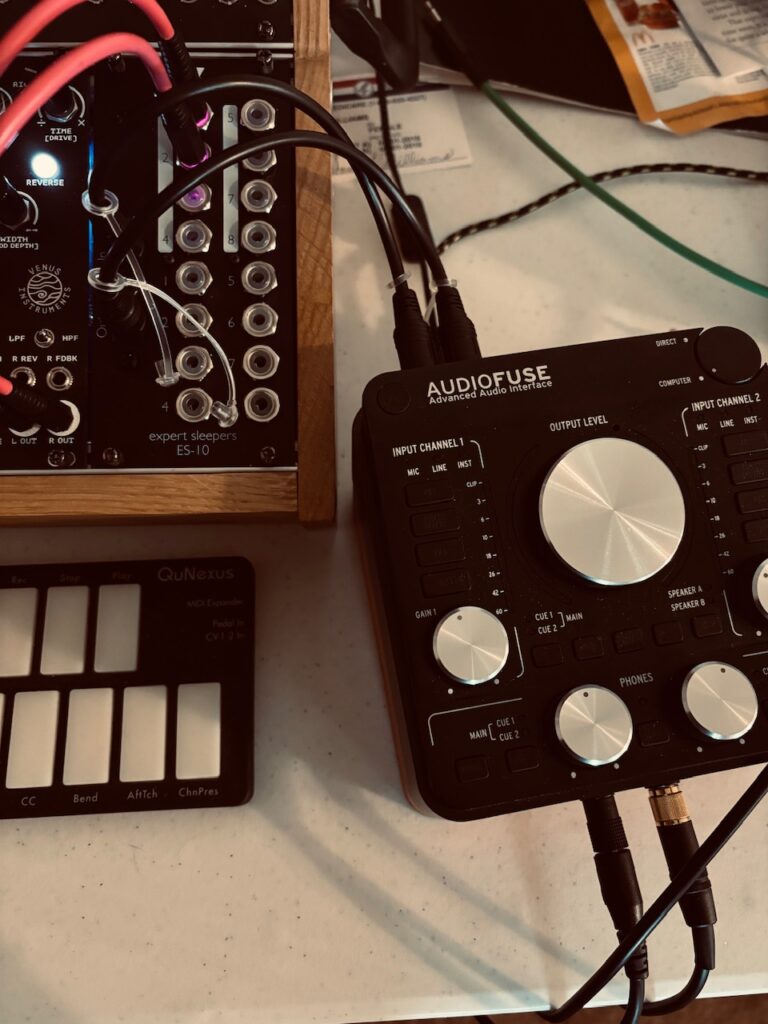
All patches were improvised and recorded in one take in AUM via the Expert Sleepers ES-10 and Arturia AudioFuse.
- Many patches go through various revisions and are played and recorded several times before I present them. ↩︎
- None of this is a criticism of the Disting NT itself. We were both completely unfamiliar with using it, and there’s a lot going on. I’m more critical of myself for having chosen a module I didn’t have at least a basic understanding of. ↩︎

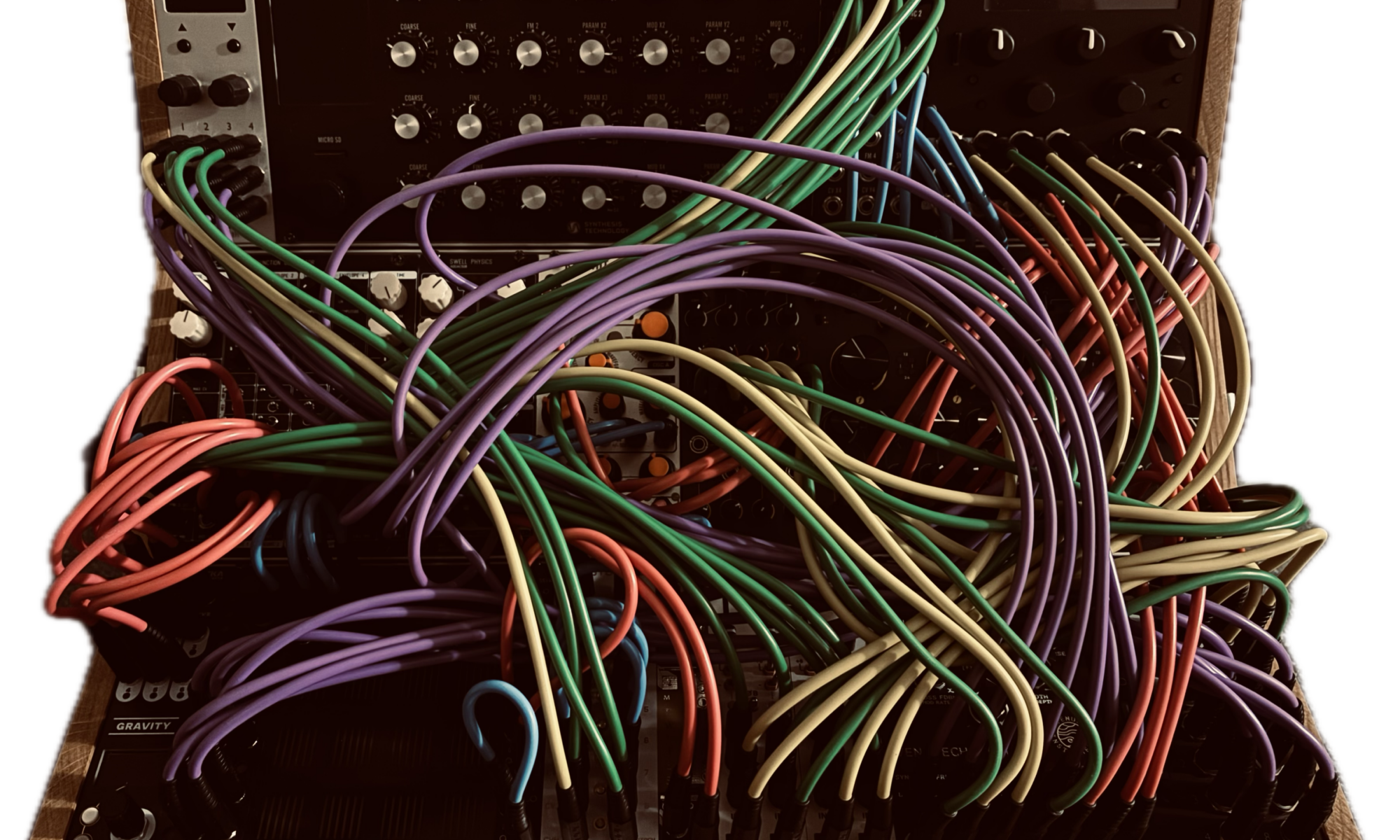
One Reply to “(SE Synth) Xmas 2024 – The Patches”
Comments are closed.